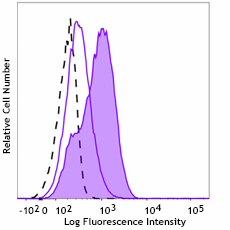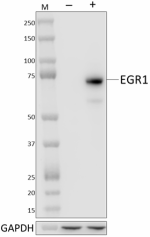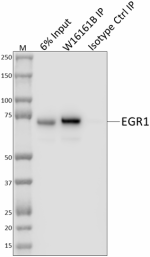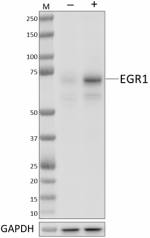- Clone
- W16161B (See other available formats)
- Regulatory Status
- RUO
- Other Names
- Early Growth Response 1, ZNF225, NGFI-A, TIS8, AT225, G0S30, KROX-24, ZIF-268, Transcription Factor ETR103
- Isotype
- Rat IgG2a, κ
- Ave. Rating
- Submit a Review
- Product Citations
- publications

-

HeLa cells treated with 100 ng/mL recombinant human EGF (Cat. No. 585508) (positive control) (filled histogram) and untreated HeLa cells (negative control) (open histogram, solid line) were fixed and permeabilized using the True-Phos™ Perm Buffer (Cat. No. 425401) and intracellularly stained with Alexa Fluor® 647 anti-EGR1 (clone W16161B) or Alexa Fluor® 647 rat IgG2a, κ isotype control (Cat. No. 400526) (open histogram, dashed line). -

ICC staining of Alexa Fluor® 647 anti-EGR1 (clone W16161B) on HeLa cells treated for one hour with 100 ng/mL recombinant human EGF (Cat. No. 585508) (positive control) (lower panels), or untreated HeLa cells (negative control) (upper panels). The cells were fixed with 4% paraformaldehyde for 10 minutes, permeabilized with 0.5% Triton X-100 for 10 minutes, blocked with 5% FBS for 1 hour at room temperature, and stained with Alexa Fluor® 647 anti-EGR1 (clone W16161B). Nuclei were counterstained with DAPI (Cat. No. 422801), and the image was captured with a 60X objective. Scale bar: 50 µm
EGR1 (early growth response protein 1) is a zinc transcription factor vital to numerous physiological processes including cell cycle, differentiation, proliferation, metabolism, DNA damage response, and apoptosis. It also functions in mitogenesis, tissue repair, fibrosis, inflammatory response and immune response through its regulation of neutrophil gene expression and association with immune response genes such as TNFα, VEGF, and matrix metalloproteinases. In the central nervous system, EGR1 functions as an immediate early gene (IEG) and is vital to neuronal function and signaling, synaptic plasticity, cognition, and memory formation. Activated by acute mechanical injury and vascular stress, EGR1 regulates multiple cardiovascular pathological processes including atherosclerosis, intimal thickening and vascular repair in response to vascular injury, ischemia, angiogenesis, and cardiac hypertrophy. EGR1 is essential to the development, homeostasis, and repair of connective tissues through its regulation of genes of the extracellular matrix. EGR1 is a component of some oncogenic pathways and stimulates tumor growth and proliferation in prostate and gastric cancers. It also regulates a variety of tumor suppressors such as p53, PTEN, NAG-1, and TGFβ1, contributes to DNA repair, and induces apoptosis of tumor cells, thus functioning in dual roles as both an oncogene and as a tumor suppressor.
Product DetailsProduct Details
- Verified Reactivity
- Human, Mouse
- Antibody Type
- Monoclonal
- Host Species
- Rat
- Immunogen
- Partial recombinant human EGR1 protein
- Formulation
-
µg size: Phosphate-buffered solution, pH 7.2, containing 0.09% sodium azide
test sizes: Phosphate-buffered solution, pH 7.2, containing 0.09% sodium azide and BSA (origin USA) - Preparation
- The antibody was purified by affinity chromatography and conjugated with Alexa Fluor® 647 under optimal conditions.
- Concentration
- µg sizes: 0.5 mg/mLtest sizes: lot-specific (to obtain lot-specific concentration and expiration, please enter the lot number in our Certificate of Analysis online tool.)
- Storage & Handling
- The antibody solution should be stored undiluted between 2°C and 8°C, and protected from prolonged exposure to light. Do not freeze.
- Application
-
ICFC (test sizes) - Quality tested
ICC (µg size) - Quality tested - Recommended Usage
-
Each lot of the test-sized antibody is quality control tested by intracellular immunofluorescent staining with flow cytometric analysis. For flow cytometric staining using the test sizes, the suggested use of this reagent is 5 µl per million cells in 100 µl staining volume or 5 µl per 100 µl of whole blood. It is recommended that the reagent be titrated for optimal performance for each application.
Each lot of the µg-sized antibody is quality control tested by immunocytochemistry. For immunocytochemistry using the ug size, a concentration range of 2.5 - 5.0 μg/mL is recommended. It is recommended that the reagent be titrated for optimal performance for each application.
* Alexa Fluor® 647 has a maximum emission of 668 nm when it is excited at 633 nm / 635 nm.
Alexa Fluor® and Pacific Blue™ are trademarks of Life Technologies Corporation.
View full statement regarding label licenses - Excitation Laser
-
Red Laser (633 nm)
- Application Notes
-
When using this clone for ICFC, we recommend using the True Phos perm buffer. We do not recommend using the True-Nuclear™ Transcription Factor Buffer Set or the Intracellular Staining Permeabilization Wash Buffer for ICFC testing due to poor EGR1 staining.
- RRID
-
AB_2941638 (BioLegend Cat. No. 943903)
AB_2941638 (BioLegend Cat. No. 943906)
AB_2941638 (BioLegend Cat. No. 943904)
Antigen Details
- Structure
- EGR1 is a 533 amino acid protein with a predicted molecular weight of 57 kD. The observed molecular weight ranges from 75 – 100 kD due to post-translational modifications.
- Distribution
-
Ubiquitously expressed/ Nucleus and cytoplasm
- Function
- Transcription factor
- Cell Type
- Neurons
- Biology Area
- Cell Biology, Transcription Factors
- Antigen References
-
- Cullen EM, et al. 2010. Mol Immunol. 47:1701-9.
- Duclot F & Kabbaj M. 2017. Front Behav Neurosci. 11:35.
- Havis E & Duprez D. 2020. Int J Mol Sci. 21:1664.
- Khachigian LM. 2006. Circ Res. 98:186-91.
- Li T, et al. 2019. Med Oncol. 37:7.
- Gene ID
- 1958 View all products for this Gene ID
- UniProt
- View information about EGR1 on UniProt.org
Related FAQs
Other Formats
View All EGR1 Reagents Request Custom Conjugation| Description | Clone | Applications |
|---|---|---|
| Purified anti-EGR1 | W16161B | WB,ICC,IP,ICFC |
| Alexa Fluor® 647 anti-EGR1 | W16161B | ICFC,ICC |
Compare Data Across All Formats
This data display is provided for general comparisons between formats.
Your actual data may vary due to variations in samples, target cells, instruments and their settings, staining conditions, and other factors.
If you need assistance with selecting the best format contact our expert technical support team.
-
Purified anti-EGR1

Whole cell extracts (15 µg total protein) from serum-starved... 
Serum-starved untreated HeLa cells (panel A) and HeLa cells ... 
Whole cell extracts (250 µg total protein) prepared from HeL... 
Whole cell extracts (15 µg total protein) from serum-starved... 
HeLa cells treated (filled histogram, positive control) or u... -
Alexa Fluor® 647 anti-EGR1

HeLa cells treated with 100 ng/mL recombinant human EGF (Cat... 
ICC staining of Alexa Fluor® 647 anti-EGR1 (clone W16161B) o...
 Login / Register
Login / Register 












Follow Us